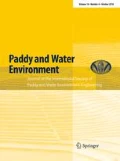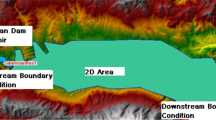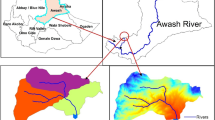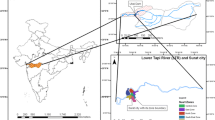Abstract
The 2011 Tohoku earthquake damaged many small earthen dams in Japan, causing flood damage and human casualties. Since then, the necessity for developing accurate inundation hazard maps for areas at risk has been highlighted. We constructed a numerical model using two-dimensional shallow-water equations with the finite element method to simulate such flood flows and tested this approach by simulating the 2011 breach of the Aotashin-ike dam and subsequent flow into the downslope Ohya-ike dam. In addition, we investigated the effect of different inflow hydrographs at a collapsed dam’s breaching point on simulated flood flow comparing three different peak timings. While the spatial extent of the simulated inundation area was not affected, the timing of flood arrival and the simulated water depth in the drainage channel were moderately affected by the inflow hydrograph; the maximum water level in the drainage channel increased with a peak timing delay. The methodology presented here can determine further efforts to better define inundation risk for Japan’s small earthen dams and provides practical procedures to account for downstream topographic features such as spillways and drainage channels.












Similar content being viewed by others
References
Alho P, Aaltonen J (2008) Comparing a 1D hydraulic model with a 2D hydraulic model for the simulation of extreme glacial outburst floods. Hydrol Proc 22(10):1537–1547. https://doi.org/10.1002/hyp.6692
Almeida GAM, Bates P, Ozdemir H (2016) Modelling urban floods at submetre resolution: challenges or opportunities for flood risk management. Flood Risk Manag 11(S2):S855–S865. https://doi.org/10.1111/jfr3.12276
Bates PD (2012) Integrating remote sensing data with flood inundation models: how far have we got? Hydrol Proc 26(16):2515–2521. https://doi.org/10.1002/hyp.9374
Begnudeli L, Sanders BF (2007) Simulation of the St. Francis dam-break flood. J Eng Mech 133(11):1200–1212. https://doi.org/10.1061/(ASCE)0733-9399(2007)133:11(1200)
Costa JE (1988) Flood from dam failures. In: Baker VR, Kochel RC, Patton PC (eds) Flood geomorphology. Wiley, New York, pp 439–463
Fewtrell TJ, Bates PD, Horritt M, Hunter NM (2008) Evaluating the effect of scale in flood inundation modelling in urban environments. Hydrol Proc 22(26):5107–5118. https://doi.org/10.1002/hyp.7148
Fewtrell TJ, Duncan A, Sampson CC, Neal JC, Bates PD (2011) Benchmarking urban flood models of varying complexity and scale using high resolution terrestrial LiDAR data. Phys Chem Earth 36(7–8):281–291. https://doi.org/10.1016/j.pce.2010.12.011
Fukumoto M, Yoshimura A, Shimazaki M (2007) Irrigation pond collapse in Kagawa Prefecture caused by heavy rainfall from Typhoon No. 23 in 2004. Bull Nat Agric Res Cent West Reg 6:167–176 (in Japanese)
Gallegos HA, Jochen ES, Sanders BF (2009) Two-dimensional, high-resolution modeling of urban dam-break flooding: a case study of Baldwin Hills, California. Adv Water Res 32(8):1323–1335. https://doi.org/10.1016/j.advwatres.2009.05.008
Hai PT, Masumoto T, Shimizu M (2008) Development of a two-dimensional finite element model for inundation processes in the Tonle Sap and its environs. Hydrol Proc 22(9):1329–1336. https://doi.org/10.1002/hyp.6942
Hai PT, Magome J, Yorozuya A, Inomata H, Fukami K (2010) Large-scale flooding analysis in the suburbs of Tokyo metropolis caused by levee breach of the Tone River using a 2D hydrodynamic model. Water Sci Technol 62(8):1859–1864. https://doi.org/10.2166/wst.2010.381
Hervouet JM (2000) A high resolution 2-D dam-break model using parallelization. Hydrol Proc 14(13):2211–2230. https://doi.org/10.1002/1099-1085(200009)14:13%3C2211:AID-HYP24%3E3.0.CO;2-8
Hervouet JM, Janin JM (1994) Finite element algorithms for modelling flood propagation. In: Molinaro P, Natale L (eds) Modelling of flood propagation over initially dry areas. ASCE, New York, pp 102–113
Inoue K, Kawaike L, Hayashi H (1999) Inundation flow modeling in urban area. Ann J Hydraul Eng 43:533–538 (in Japanese)
Kato T (2005) Flood mitigation function and its stochastic evaluation of irrigation ponds: evaluation of flood mitigation function of the Matsuzawa-ike pond, Osaka Prefecture, Japan. Bull Nat Res Inst Agric Eng 44:1–22 (in Japanese)
Kawahara M, Umetsu T (1986) Finite element method for moving boundary problems in river flow. Int J Numer Methods Fluids 6(6):365–386. https://doi.org/10.1002/fld.1650060605
Kawahara M, Hirano H, Tsubota K, Inagaki K (1982) Selective lumping finite element method for shallow water flow. Int J Numer Methods Fluids 2(1):89–112. https://doi.org/10.1002/fld.1650020106
Kawamoto O, Suzuki H, Fukuhara M, Yoshisako H, Inoue K, Suzuki T (2013) On the improvement of simplified analysis of flooding due to breaks of fill dam. J Jpn Soc Irrig Drain Rural Eng 81(8):7–11 (in Japanese)
Kawata Y, Koike N (1997) On a hazard map of tsunami flooding. Dis Prev Res Inst Ann 40(B-2):75–92 (in Japanese)
Kiri H, Kubota T, Tosaka N, Tanji H, Nakaya T (2004) Finite element model for flooding on agricultural field considering small channel. J Appl Mech 7:423–430 (in Japanese)
Kiri H, Tanji H, Shiratani E (2011) The quasi-Lagrange flood model for applying to an unstructured grid analysis. J Jpn Soc Civ Eng 67(2):441–445 (in Japanese)
Kojima H, Kohgo Y, Shimada K, Shoda D, Suzuki H (2016) Flood analysis of the small earth dam break caused by the 2011 off the Pacific coast of Tohoku earthquake. Trans Jpn Soc Irrig Drain Rural Eng 84(2):93–101 (in Japanese with English abstract)
Marks K, Bates P (2000) Integration of high-resolution topographic data with floodplain flow models. Hydrol Proc 14(11–12):2109–2122. https://doi.org/10.1002/1099-1085(20000815/30)14:11/12%3C2109:AID-HYP58%3E3.0.CO;2-1
Ono K, Kazama S, Kawagoe S, Yokoo Y, Gunawardhana L (2011) Possible earthen dam failure mechanisms of Fujinuma reservoir due to the Great East Japan Earthquake of 2011. Hydrol Res Lett 5:69–72. https://doi.org/10.3178/hrl.5.69
Shoda D, Kawamoto O, Suzuki H, Yoshisako H, Inoue K, Kojima H (2014) Inundation analysis of failure dam due to heavy rain in 2013. Tech Rep Nat Inst Rural Eng 215:91–101 (in Japanese)
Shoda D, Yoshisako H, Inoue K, Toshikazu H (2015) Inundation analysis method under heavy rain for failure small earth filldam. J Jpn Soc Irrig Drain Rural Eng 83(4):291–294 (in Japanese)
Tani S, Inoue K (2009) Analysis of inundation caused by failure of small earth dams and the way of evaluation of the damage in the downstream sites. Tech Rep Natl Inst Rural Eng Jpn 210:137–144 (in Japanese)
Uchida T, Kawahara Y, Kinashi Y, Ito Y (2007) A high-resolution simulator for inundation flows in urban districts and its application to Takehara city due to storm surge. Proc Hydraul Eng 51:517–522. https://doi.org/10.2208/prohe.51.517
Wakabayashi N (2005) Damage of the irrigation ponds in Awaji-shima by the typhoon #23. J Agric Eng Soc Jpn 73(8):669–672 (in Japanese)
Worni R, Stoffel M, Huggel C, Volz C, Casteller A, Luckman B (2012) Analysis and dynamic modeling of a moraine failure and glacier lake outburst flood at Ventisquero Negro, Patagonian Andes (Argentina). J Hydrol 444–445(11):134–145. https://doi.org/10.1016/j.jhydrol.2012.04.013
Yu D, Lane SN (2006) Urban fluvial flood modelling using a two-dimensional diffusion-wave treatment, part 1: mesh resolution effects. Hydrol Proc 20(7):1541–1565. https://doi.org/10.1002/hyp.5935
Acknowledgements
The authors thank the staff of Fukushima Prefecture and Motomiya City for providing data and supporting our field observations. We would like to thank Editage (www.editage.jp) for English language editing.
Author information
Authors and Affiliations
Corresponding author
Rights and permissions
About this article
Cite this article
Kojima, H., Kohgo, Y., Shimada, K. et al. Numerical modeling of flood flow after small earthen dam failure: a case study from the 2011 Tohoku earthquake. Paddy Water Environ 18, 431–442 (2020). https://doi.org/10.1007/s10333-020-00792-w
Received:
Revised:
Accepted:
Published:
Issue Date:
DOI: https://doi.org/10.1007/s10333-020-00792-w




